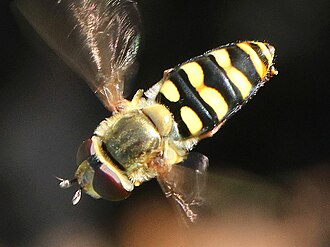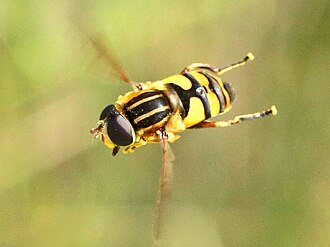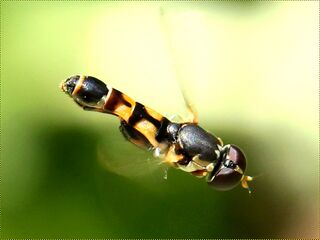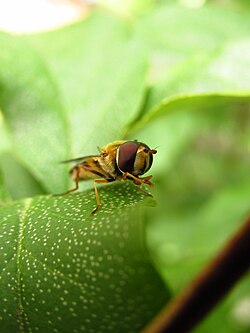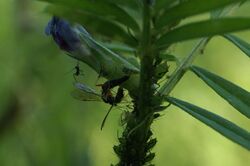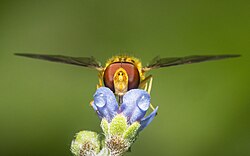Biology:Hoverfly: Difference between revisions
(url) |
(url) |
||
| Line 1: | Line 1: | ||
{{short description|Family of insects}} | {{short description|Family of insects}} | ||
{{For|the helicopter|Sikorsky R-4}} | |||
{{Automatic taxobox | {{Automatic taxobox | ||
| name = Syrphidae | | name = Syrphidae | ||
| Line 10: | Line 11: | ||
| subdivision_ranks = Subfamilies | | subdivision_ranks = Subfamilies | ||
| subdivision = *[[Biology:Eristalinae|Eristalinae]] | | subdivision = *[[Biology:Eristalinae|Eristalinae]] | ||
*[[Biology:Microdontinae|Microdontinae]] | * [[Biology:Microdontinae|Microdontinae]] | ||
*[[Biology:Pipizinae|Pipizinae]] | * [[Biology:Pipizinae|Pipizinae]] | ||
*[[Biology:Syrphinae|Syrphinae]] | * [[Biology:Syrphinae|Syrphinae]] | ||
}} | }} | ||
'''Hoverflies''', also called '''flower flies''' or '''syrphids''', make up the [[Biology:Insect|insect]] family '''Syrphidae'''. As their [[Biology:Common name|common name]] suggests, they are often seen [[Biology:Hover (behaviour)|hovering]] or nectaring at [[Biology:Flower|flower]]s; the adults of many [[Biology:Species|species]] feed mainly on [[Biology:Nectar|nectar]] and [[Biology:Pollen|pollen]], while the [[Biology:Larva|larva]]e ([[Biology:Maggot|maggot]]s) eat a wide range of foods. In some species, the larvae are saprotrophs, eating decaying plant and animal matter in the soil or in ponds and streams. In other species, the larvae are [[Biology:Insectivore|insectivore]]s | '''Hoverflies''', also called '''flower flies''' or '''syrphids''', make up the [[Biology:Insect|insect]] [[Social:Family|family]] '''Syrphidae'''. As their [[Biology:Common name|common name]] suggests, they are often seen [[Biology:Hover (behaviour)|hovering]] or nectaring at [[Biology:Flower|flower]]s; the adults of many [[Biology:Species|species]] feed mainly on [[Biology:Nectar|nectar]] and [[Biology:Pollen|pollen]], while the [[Biology:Larva|larva]]e ([[Biology:Maggot|maggot]]s) eat a wide range of foods. In some species, the larvae are saprotrophs, specifically [[Biology:Detritivore|detritivore]]s,<ref>{{cite journal |last=Rotheray |first=G.E. |year=1993 |title= Colour Guide to Hoverfly Larvae (Diptera, Syrphidae) in Britain and Europe |journal=Dipterists Digest |volume=9 |pages=155 |url= https://diptera.info/downloads/df_1_9_Colour_Guide_to%20Hoverfly_Larvae.pdf }}</ref> eating decaying plant and animal matter in the soil or in ponds and streams. In other species, the larvae are [[Biology:Insectivore|insectivore]]s, preying on [[Biology:Aphid|aphid]]s, thrips, and other plant-sucking insects. | ||
Insects such as [[Biology:Aphid|aphid]]s are considered crop pests, | Insects such as [[Biology:Aphid|aphid]]s are considered crop pests, so the aphid-eating larvae of some hoverflies are economically and ecologically important. The larvae are potential agents for use in biological control, while the adults are [[Biology:Pollinator|pollinator]]s. | ||
About 6,000 species in 200 [[Biology:Genus|genera]] have been described. Hoverflies are common throughout the world and can be found on all continents except [[Earth:Antarctica|Antarctica]]. Hoverflies are harmless to most [[Biology:Mammal| | About 6,000 species in 200 [[Biology:Genus|genera]] have been described. Hoverflies are common throughout the world and can be found on all continents except [[Earth:Antarctica|Antarctica]]. Hoverflies are harmless to most [[Biology:Mammal|mammal]]s, though many species are [[Biology:Batesian mimicry|mimics]] of stinging [[Biology:Wasp|wasp]]s and [[Biology:Bee|bee]]s, a mimicry which may serve to ward off predators. | ||
Hoverfly hovering behavior is unlike that of hummingbirds since they do not feed in midair. Hovering in general may be a means of finding a food source | Hoverfly hovering behavior is unlike that of hummingbirds since they do not feed in midair. Hovering in general may be a means of finding a food source. Male hovering is often a territorial display while seeking females,<ref name="Scopus">{{cite journal |last1=Collett |first1=T.S. |last2=Land |first2=M.F. |date=September 1978 |journal=Journal of Comparative Physiology |title=How hoverflies compute interception courses |url=https://www.scopus.com/record/display.uri?eid=2-s2.0-0001324077&origin=inward&txGid=ad71bb12cbc836c7415c848ba45e1ee5 |pages=191–204 |volume=125 |issue=3 |doi=10.1007/BF00656597 |publisher=Springer-Verlag }}</ref> | ||
while female hovering serves to inspect ovipositing sites. <ref | while female hovering serves to inspect ovipositing sites.<ref>{{cite journal |last1=Almohamad |first1=Raki |last2=Verheggen |first2=François J. |last3=HaubrugeUniv |first3=Éric |date=2009 |journal=Biotechnologie, Agronomie, Société et Environnement |title=Searching and oviposition behavior of aphidophagous hoverflies (Diptera: Syrphidae): a review |url=https://www.researchgate.net/publication/26849775 |pages=467–481 |volume=13 |issue=3 }}</ref><ref name="ucanr">{{cite web |url=https://ucanr.edu/sites/tuolumne_county_master_gardeners/files/147388.pdf |title=Hover Flies, a Gardener's Friend |author=Vera Strader |publisher=University of California Agriculture and Natural Resources }}</ref><ref name="Bugguide">{{cite web |url=https://bugguide.net/node/view/2317562 |title=''Allograpta exotica'' ovipositing - ''Allograpta exotica'' - Female |author=Peter Chen |date=December 6, 2023 |publisher=Iowa State University |website=Bugguide }}</ref> | ||
<gallery caption="Adult hoverflies often hover over the plants they visit" mode=packed heights=160px>| | <gallery caption="Adult hoverflies often hover over the plants they visit" mode=packed heights=160px>| | ||
Eupeodes_fumipennis-female_hovering.jpg|''[[Biology:Eupeodes fumipennis|Eupeodes fumipennis]]'' | Eupeodes_fumipennis-female_hovering.jpg|''[[Biology:Eupeodes fumipennis|Eupeodes fumipennis]]'' | ||
| Line 29: | Line 30: | ||
Syritta_pipiens-male_hovering.jpg|''[[Biology:Syritta pipiens|Syritta pipiens]]'' | Syritta_pipiens-male_hovering.jpg|''[[Biology:Syritta pipiens|Syritta pipiens]]'' | ||
</gallery> | </gallery> | ||
[[File:Syrphidae - kanagawa japan - 2023 11 9.ogv|thumb|A hoverfly on flowers in [[Japan]]]] | |||
==Description== | ==Description== | ||
The size of hoverflies varies depending on the species.<ref name="Britannica">{{cite encyclopedia|url=https://www.britannica.com/EBchecked/topic/273341/hover-fly|title=hoverfly |encyclopedia=[[Encyclopædia Britannica]] Online |year=2009 |access-date=December 5, 2009}}</ref> For example ''[[Biology:Paragus tibialis|Paragus tibialis]]''<ref name="Stubbs">{{cite book |last1=Stubbs |first1=Alan E. |last2=Falk |first2=Steven J |title=British Hoverflies: An Illustrated Identification Guide |edition=2nd |year=1983 |publisher=British Entomological and Natural History Society |location=London |isbn=1-899935-03-7 |pages=253, xvpp }}</ref><ref name="atlas">{{cite book |last1=Ball |first1=S.G. |last2=Morris |first2=R.K.A. |title=Provisional atlas of British hoverflies (Diptera, Syrphidae) |year=2000 |publisher=Biological Record Centre |location=Monks Wood, UK |isbn=1-870393-54-6 |pages=167 pages<!-- ? needs actual page number? -->}}</ref><ref name="VanVeen">{{cite book |last= Van Veen |first= M.P. |title=Hoverflies of Northwest Europe, Identification Keys to the Syrphidae |type= Hardback |year=2004 |publisher=KNNV Publishing |location=Utrecht |isbn=90-5011-199-8 |page=254 }}</ref> is {{convert|3-5|mm|in|frac=64|abbr=on}} long, while ''[[Biology:Criorhina nigriventris|Criorhina nigriventris]]'' is {{convert|13.6-20.6|mm|in|frac=32|abbr=on}} long.<ref name=skev>{{cite book |last=Skevington |first=Jeffrey H. |date=2019 |title= Field Guide to the Flower Flies of Northeastern North America |url= |location= |publisher= |page= |isbn= 9780691189406 }}</ref> Some, such as members of the genus ''[[Biology:Baccha|Baccha]]'', are small, elongated, and slender, while others, such as members of ''[[Biology:Criorhina|Criorhina]]'', are large, hairy, and yellow and black. As members of the [[Biology:Diptera|Diptera]], all hoverflies have a single functional pair of wings, with the hind wings reduced to [[Biology:Halteres|balancing organs]].<ref name="Hutchinson">{{cite encyclopedia |url=http://encyclopedia.farlex.com/Hover+Fly|title=Hoverfly|access-date=December 6, 2009 |encyclopedia=Hutchinson Encyclopedia |publisher=Helicon Publishing |year=2009}}</ref> Many species are brightly colored, with spots, stripes, and bands of yellow or brown covering their bodies.<ref name="Hutchinson" /> Due to this coloration, they are often mistaken both by insect-eating birds and by humans for wasps or [[Biology:Bee|bee]]s; they exhibit [[Biology:Batesian mimicry|Batesian mimicry]]. Despite this, hoverflies are harmless to humans.<ref name="Britannica" /> Drone flies, ''[[Biology:Eristalis tenax|Eristalis tenax]],'' are an example of a species of hoverfly who exhibit Batesian mimicry.<ref name="p815">{{cite journal | last=Heal | first=Jonathan | title=Colour patterns of syrphidae: | journal=Heredity | publisher=Springer Science and Business Media LLC | volume=42 | issue=2 | year=1979 | issn=0018-067X | doi=10.1038/hdy.1979.24 | pages=223–236}}</ref> | |||
With a few exceptions,<ref name="Reemer08">{{cite journal |last=Reemer |first=Menno |year=2008 |title=''Surimyia'', a new genus of Microdontinae, with notes on ''Paragodon'' Thompson, 1969 (Diptera, Syrphidae) |journal=Zoologische Mededelingen |volume=82 |pages=177–188 |url=http://www.repository.naturalis.nl/record/261778 |format=[[Portable Document Format|PDF]]}}</ref> Hoverflies are distinguished from other flies by having a spurious vein, located parallel to their fourth longitudinal wing vein.<ref name="Britannica" /> Adults feed mainly on [[Biology:Nectar|nectar]] and [[Biology:Pollen|pollen]].<ref name="Hutchinson" /> Many species also hover around flowers, lending to their common name.<ref name="Britannica" /> | |||
With a few exceptions,<ref name="Reemer08">{{cite journal |last=Reemer |first=Menno |year=2008 |title=''Surimyia'', a new genus of Microdontinae, with notes on ''Paragodon'' Thompson, 1969 (Diptera, Syrphidae) |journal=Zoologische Mededelingen |volume=82 |pages=177–188 |url=http://www.repository.naturalis.nl/record/261778 |format=PDF}}</ref> Hoverflies are distinguished from other flies by having a spurious vein, located parallel to their fourth longitudinal wing vein.<ref name="Britannica" /> Adults feed mainly on [[Biology:Nectar|nectar]] and [[Biology:Pollen|pollen]].<ref name="Hutchinson" /> Many species also hover around flowers, lending to their common name.<ref name="Britannica" /> | |||
* The legs and mouthparts of hoverflies are usually not particularly long and thin (some bombyliids have a long and needle-like proboscis, many have legs that are noticeably longer and thinner than in similar-sized syrphids) | * The legs and mouthparts of hoverflies are usually not particularly long and thin (some bombyliids have a long and needle-like proboscis, many have legs that are noticeably longer and thinner than in similar-sized syrphids) | ||
| Line 42: | Line 42: | ||
* The wings are often clear or have smooth gradients of tinting, and their veins merge posteriorly into a "false edge" that runs parallel to the wing's true rear edge and extends along half or more of the wing length (bombyliid wings lack a "false rear edge" and often have large dark areas with sharp boundaries, or complex patterns of spots). | * The wings are often clear or have smooth gradients of tinting, and their veins merge posteriorly into a "false edge" that runs parallel to the wing's true rear edge and extends along half or more of the wing length (bombyliid wings lack a "false rear edge" and often have large dark areas with sharp boundaries, or complex patterns of spots). | ||
* Their abdomens and thoraces often have glossy cuticular body surfaces, abdominal colors are usually mainly due to cuticular pigments (bee flies are usually very hairy, their abdominal colors are almost always due to pigmentation of hairs and not the underlying cuticle). | * Their abdomens and thoraces often have glossy cuticular body surfaces, abdominal colors are usually mainly due to cuticular pigments (bee flies are usually very hairy, their abdominal colors are almost always due to pigmentation of hairs and not the underlying cuticle). | ||
[[File:ハナアブ.jpg|thumb|Their wariness of people is surprisingly low, and their | [[File:ハナアブ.jpg|thumb|Their wariness of people is surprisingly low, and their behaviour can be observed up close.]] | ||
== Reproduction and life cycle == | == Reproduction and life cycle == | ||
[[File:Hoverflies mating midair.jpg|thumb|right|Midair mating of ''[[ | [[File:Hoverflies mating midair.jpg|thumb|right|Midair mating of ''[[Simosyrphus grandicornis]]'']] | ||
Unlike adults, the [[Biology:Maggot|maggot]]s of hoverflies feed on a variety of foods | Unlike adults, the [[Biology:Maggot|maggot]]s of hoverflies feed on a variety of foods. Some are saprotrophs, eating decaying plant or animal matter, while others are insectivores, eating aphids, thrips, and other plant-sucking insects.<ref name="Britannica" /><ref name="Schmidt">{{cite journal |last1=Schmidt |first1=Martin |last2=Thewes |first2=Ulrich |last3=Thies |first3=Carsten |last4=Tscharntke |first4=Teja |title=Aphid suppression in mulched cereals |journal=Entomologia Experimentalis et Applicata |date=2004 |volume=113 |issue=2 |pages=87–93 |doi=10.1111/j.0013-8703.2004.00205.x |s2cid=85070615 }}</ref> Predatory species are beneficial to farmers and gardeners, because aphids destroy crops, and hoverfly maggots are often used in biological control. That includes one of the most common widespread hoverfly species, ''[[Biology:Episyrphus balteatus|Episyrphus balteatus]]'', the larvae of which feed on aphids.{{cn|date=February 2025}} | ||
[[File:Hoverfly depositing egg.jpg|thumb|right| | [[File:Hoverfly depositing egg.jpg|thumb|right|Hoverfly depositing egg on ''[[Epipactis helleborine]]'' which has ants farming aphids]] | ||
An example of a well-known hoverfly maggot is the [[Biology:Rat-tailed maggot|rat-tailed maggot]] | An example of a well-known hoverfly maggot is the [[Biology:Rat-tailed maggot|rat-tailed maggot]] of the drone fly, ''[[Biology:Eristalis tenax|Eristalis tenax]]''. It has a breathing siphon at its rear end, giving it its name.<ref name="Britannica" /> The species lives in stagnant water, such as sewage and lagoons.<ref name="Maggots">{{cite journal |vauthors=Aguilera A, Cid A, Regueiro BJ, Prieto JM, Noya M |title=Intestinal myiasis caused by ''Eristalis tenax'' |journal=[[Biology:Journal of Clinical Microbiology|Journal of Clinical Microbiology]] |volume=37 |issue=9 |pages=3082 |date=September 1999 |doi=10.1128/JCM.37.9.3082-3082.1999 |pmid=10475752 |pmc=85471 }}</ref> The maggots also have a commercial use, and are sometimes sold for [[Earth:Ice fishing|ice fishing]].<ref name="Ice fishing maggots">[http://www.briancoad.com/Dictionary/M.htm Dictionary of Ichthyology; Brian W. Coad and Don E. McAllister] {{webarchive|url=https://web.archive.org/web/20091206035232/http://www.briancoad.com/Dictionary/M.htm |date=2009-12-06 }} at ww.briancoad.com</ref> | ||
[[File:Parasitoid wasp oviposits inside hoverfly larva.jpg|thumb|right|[[ | [[File:Parasitoid wasp oviposits inside hoverfly larva.jpg|thumb|right|[[Ichneumonidae|An ichneumonid wasp]] [[Biology:Ovipositor|ovipositing]] inside a hoverfly larva]] | ||
Very rarely, hoverfly larvae have caused [[Medicine:Myiasis#Accidental myiasis|accidental myiasis]] in humans. | Very rarely, hoverfly larvae have caused [[Medicine:Myiasis#Accidental myiasis|accidental myiasis]] in humans. That occurs when the larvae are accidentally ingested from contaminated food.<ref name="Maggots" /><ref>{{cite journal |author=Whish-Wilson PB |title=A possible case of intestinal myiasis due to ''Eristalis tenax'' |journal=The Medical Journal of Australia |volume=173 |issue=11–12 |pages=652 |year=2000 |pmid=11379520 |url=http://www.mja.com.au/public/issues/173_11_041200/whishwilson/whishwilson.html|doi=10.5694/j.1326-5377.2000.tb139374.x |s2cid=12898612 }}</ref> | ||
== Evolution == | == Evolution == | ||
The oldest known fossils of [[Biology:Crown group|crown group]] [[Biology:Syrphidae|Syrphidae]] are from the [[Earth:Eocene|Eocene]] aged Florissant Formation, [[Earth:Green River Formation|Green River Formation]] and [[Earth:Baltic amber|Baltic amber]]. The genus ''Prosyrphus'', found in [[Earth:Late Cretaceous|Late Cretaceous]] ([[Earth:Cenomanian|Cenomanian]]) [[Earth:Burmese amber|Burmese amber]], appears to represent a stem group to the family.<ref>{{Cite journal|last=Grimaldi|first=David A.|date=2018-10-24|title=Basal Cyclorrhapha in amber from the Cretaceous and Tertiary (Insecta: Diptera), and their relationships: Brachycera in Cretaceous amber Part IX|journal=Bulletin of the American Museum of Natural History|volume=423|issue=423|pages=1–97|doi=10.1206/0003-0090-423.1.1|s2cid=91679754|issn=0003-0090|url=https://zenodo.org/record/4613008}}</ref> | |||
The oldest known fossils of crown group [[Biology:Syrphidae|Syrphidae]] are from the [[Earth:Eocene|Eocene]] aged Florissant Formation, [[Earth:Green River Formation|Green River Formation]] and [[Earth:Baltic amber|Baltic amber]]. | |||
== Distribution and habitat == | == Distribution and habitat == | ||
Hoverflies are a [[Biology:Cosmopolitan distribution|cosmopolitan]] family found in most [[Biology:Biome|biome]]s, except extreme deserts, [[Earth:Tundra|tundra]] at extremely high latitudes, and [[Earth:Antarctica|Antarctica]].<ref name="Iziko">{{cite web |url=http://www.biodiversityexplorer.org/flies/syrphidae/index.htm |title=Syrphidae (hoverflies) |access-date=December 11, 2009|last=Barkemeyer|first=Werner|location=South Africa |publisher=[[Organization:Iziko South African Museum|Iziko Museum]] |work=Biodiversity Explorer |archive-date=September 23, 2015 |archive-url=https://web.archive.org/web/20150923190349/http://www.biodiversityexplorer.org/flies/syrphidae/index.htm |url-status=dead}}</ref><ref>{{cite web |url=http://www.sel.barc.usda.gov/diptera/syrphid/syrphid.htm |title=Flower Flies |access-date=December 11, 2009 |publisher=[[Organization:United States Department of Agriculture|United States Department of Agriculture]]|work=The Diptera Site |last=Thompson |first=F. Christian|date=August 19, 1999|url-status=dead|archive-url=https://web.archive.org/web/20091211155805/http://www.sel.barc.usda.gov/Diptera/syrphid/syrphid.htm|archive-date=December 11, 2009}}</ref> Certain species are more common in certain areas than others; for example, the American hoverfly, ''Eupeodes americanus'', is common in the [[Biology:Nearctic realm|Nearctic realm]], and the common hoverfly, ''Melangyna viridiceps'', is common in the [[Biology:Australasian realm|Australasian realm]]. About 6,000 species and 200 genera are in the family.<ref>{{cite book |editor1=Gary Mullen |editor2=Gary Richard Mullen |editor3=Lance Durden |year=2009 |title=Medical and Veterinary Entomology |edition=2nd |publisher=[[Company:Academic Press|Academic Press]] |isbn=978-0-12-372500-4 |chapter=Myiasis (Muscoidea, Oestroidea) |author1=Philip J. Scholl |author2=E. Paul Catts |author3=Gary R. Mullen |pages=309–338 |chapter-url=https://books.google.com/books?id=6R1v9o-uaI4C&pg=PA309}}</ref> | |||
While some hoverfly larvae are aquatic and are often found in stagnant water, those of species that prey upon aphids and other plant parasites are usually terrestrial, residing on leaves.<ref>{{cite web|url=http://www.bumblebee.org/invertebrates/DipteraHoverflies.htm|title=Syrphidae, hoverflies|author=Laura Smith|work=bumblebee.org}}</ref> Adults are often found near flowers, their principal food source being nectar and pollen.<ref name="Hutchinson" /> Some species are [[Biology:Inquiline|inquiline]]s; for instance, members of the genus ''[[Biology:Volucella|Volucella]]'' can be found in bumblebee nests, while members of ''[[Biology:Microdon|Microdon]]'' are myrmecophiles, found in ant or termite nests.<ref name="Britannica" /> Others can be found in decomposing vegetation.{{cn|date=February 2025}} | |||
While some hoverfly larvae are aquatic and are often found in stagnant water, those of species that prey upon aphids and other plant parasites are usually terrestrial, residing on leaves.<ref>{{cite web|url=http://www.bumblebee.org/invertebrates/DipteraHoverflies.htm|title=Syrphidae, hoverflies|author=Laura Smith|work=bumblebee.org}}</ref> Adults are often found near flowers, their principal food source being nectar and pollen.<ref name="Hutchinson" /> Some species are [[Biology:Inquiline|inquiline]]s; for instance, members of the genus ''[[Biology:Volucella|Volucella]]'' can be found in bumblebee nests, while members of ''[[Biology:Microdon|Microdon]]'' are myrmecophiles, found in ant or termite nests.<ref name="Britannica" /> Others can be found in decomposing vegetation. | |||
==Pollination== | ==Pollination== | ||
| Line 74: | Line 72: | ||
[[File:ComputerHotline - Syrphidae sp. (by) (3).jpg|thumb|''Eupeodes corollae'']] | [[File:ComputerHotline - Syrphidae sp. (by) (3).jpg|thumb|''Eupeodes corollae'']] | ||
Hoverflies are important pollinators of flowering plants in many ecosystems worldwide.<ref name="Larson 2001 439–465">{{cite journal|last1=Larson|first1=B.M.H. |last2=Kevan |first2=P.G. |last3=Inouye|first3=D. W.|title=Flies and flowers: taxonomic diversity of anthophiles and pollinators.|journal=Canadian Entomologist |year=2001 |volume=133 |issue=4 |pages=439–465 |doi=10.4039/ent133439-4 |s2cid=55767580 }}</ref> Syrphid flies are frequent flower visitors to a wide range of wild plants, as well as agricultural crops, and are often considered the second-most important group of pollinators after wild bees. | Hoverflies are important pollinators of flowering plants in many ecosystems worldwide.<ref name="Larson 2001 439–465">{{cite journal|last1=Larson|first1=B.M.H. |last2=Kevan |first2=P.G. |last3=Inouye|first3=D. W.|title=Flies and flowers: taxonomic diversity of anthophiles and pollinators.|journal=Canadian Entomologist |year=2001 |volume=133 |issue=4 |pages=439–465 |doi=10.4039/ent133439-4 |s2cid=55767580 }}</ref> Syrphid flies are frequent flower visitors to a wide range of wild plants, as well as agricultural crops, and are often considered the second-most important group of pollinators after wild bees. Relatively little research into fly pollinators has been conducted, compared to bees.<ref name="Larson 2001 439–465" /> Bees are thought to be able to carry a greater volume of pollen on their bodies, but flies may be able to compensate for this by making a greater number of flower visits.{{cn|date=February 2025}} | ||
Like many pollinator groups, syrphid flies range from species that take a [[Earth:Generalist and specialist species|generalist]] approach to foraging by visiting a wide range of plant species through those that specialize in a narrow range of plants.<ref>{{Cite journal |doi=10.1111/plb.12328 |pmid=25754608 |title=Competition for pollinators and intra-communal spectral dissimilarity of flowers |journal=Plant Biology |volume=18 |issue=1 |pages=56–62 |year=2015 |last1=Van Der Kooi |first1=C. J. |last2=Pen |first2=I. |last3=Staal |first3=M. |last4=Stavenga |first4=D. G. |last5=Elzenga |first5=J. T. M. |url=https://www.researchgate.net/publication/273158762}}</ref> Although hoverflies are often considered mainly nonselective pollinators, some hoverflies species are highly selective and carry pollen from one plant species.<ref>{{cite journal |last=Haslett |first=J.R. |title=Interpreting patterns of resource utilization: randomness and selectivity in pollen feeding by adult hoverflies |journal=Oecologia |year=1989 |volume=78 |issue=4 |pages=433–442 |doi=10.1007/bf00378732 |pmid=28312171 |bibcode=1989Oecol..78..433H |s2cid=9178645}}</ref> ''Cheilosia albitarsis'' is thought to only visit ''Ranunculus repens''. | Like many pollinator groups, syrphid flies range from species that take a [[Earth:Generalist and specialist species|generalist]] approach to foraging by visiting a wide range of plant species through those that specialize in a narrow range of plants.<ref>{{Cite journal |doi=10.1111/plb.12328 |pmid=25754608 |title=Competition for pollinators and intra-communal spectral dissimilarity of flowers |journal=Plant Biology |volume=18 |issue=1 |pages=56–62 |year=2015 |last1=Van Der Kooi |first1=C. J. |last2=Pen |first2=I. |last3=Staal |first3=M. |last4=Stavenga |first4=D. G. |last5=Elzenga |first5=J. T. M. |url=https://www.researchgate.net/publication/273158762}}</ref> Although hoverflies are often considered mainly nonselective pollinators, some hoverflies species are highly selective and carry pollen from one plant species.<ref>{{cite journal |last=Haslett |first=J.R. |title=Interpreting patterns of resource utilization: randomness and selectivity in pollen feeding by adult hoverflies |journal=Oecologia |year=1989 |volume=78 |issue=4 |pages=433–442 |doi=10.1007/bf00378732 |pmid=28312171 |bibcode=1989Oecol..78..433H |s2cid=9178645}}</ref> ''Cheilosia albitarsis'' is thought to only visit ''Ranunculus repens''.{{cn|date=February 2025}} | ||
Specific flower preferences differ among species, but syrphid fly species have repeatedly been shown to prefer white- and yellow-coloured flowers.<ref>{{cite journal|last1=Sajjad|first1=Asif|last2=Saeed|first2=Shafqat|title=Floral host plant range of syrphid flies (Syrphidae: Diptera) under natural conditions in southern punjab, Pakistan.|journal=Pakistan Journal of Biology|year=2010|volume=42 |issue=2|pages=1187–1200}}</ref> Nonvisual flower cues such as olfactory cues also help these flies to find flowers, especially those that are not yellow.<ref>{{cite journal |last1=Primante|first1=Clara|last2=Dotterl|first2=Stefan|title=A syrphid fly uses olfactory cues to find a non-yellow flower.|journal=Journal of Chemical Ecology|year=2010|volume=36 |issue=11|pages=1207–1210|doi=10.1007/s10886-010-9871-6|pmid=20924654|s2cid=23245484}}</ref> Many syrphid fly species have short, unspecialized mouth parts and tend to feed on flowers that are more open as the nectar and pollen can be easily accessed.<ref>{{cite journal|last1=Campbell|first1=Alistair, J. |last2=Biesmeijer |first2=J. C. |last3=Varma |first3=V. |last4=Wakers |first4=F. L. |title=Realising multiple ecosystem services based on the response of three beneficial insect groups to floral traits and trait diversity |journal=Basic and Applied Ecology |year=2012 |volume=13 |issue=4 |pages=363–370 |doi=10.1016/j.baae.2012.04.003}}</ref> | Specific flower preferences differ among species, but syrphid fly species have repeatedly been shown to prefer white- and yellow-coloured flowers.<ref>{{cite journal|last1=Sajjad|first1=Asif|last2=Saeed|first2=Shafqat|title=Floral host plant range of syrphid flies (Syrphidae: Diptera) under natural conditions in southern punjab, Pakistan.|journal=Pakistan Journal of Biology|year=2010|volume=42 |issue=2|pages=1187–1200}}</ref> Nonvisual flower cues such as olfactory cues also help these flies to find flowers, especially those that are not yellow.<ref>{{cite journal |last1=Primante|first1=Clara|last2=Dotterl|first2=Stefan|title=A syrphid fly uses olfactory cues to find a non-yellow flower.|journal=Journal of Chemical Ecology|year=2010|volume=36 |issue=11|pages=1207–1210|doi=10.1007/s10886-010-9871-6|pmid=20924654|s2cid=23245484}}</ref> Many syrphid fly species have short, unspecialized mouth parts and tend to feed on flowers that are more open as the nectar and pollen can be easily accessed.<ref>{{cite journal|last1=Campbell|first1=Alistair, J. |last2=Biesmeijer |first2=J. C. |last3=Varma |first3=V. |last4=Wakers |first4=F. L. |title=Realising multiple ecosystem services based on the response of three beneficial insect groups to floral traits and trait diversity |journal=Basic and Applied Ecology |year=2012 |volume=13 |issue=4 |pages=363–370 |doi=10.1016/j.baae.2012.04.003}}</ref> | ||
| Line 87: | Line 85: | ||
==Relationship with humans== | ==Relationship with humans== | ||
[[File:Hoverfly in rain by prasan shrestha.jpg|thumb| | [[File:Hoverfly in rain by prasan shrestha.jpg|thumb|Hoverfly nectaring on a small flower bud covered with dew drops.]] | ||
Adult syrphid flies are pollinators. | Adult syrphid flies are pollinators.{{cn|date=February 2025}} | ||
Larvae of many hoverfly species prey upon pest insects, including [[Biology:Aphid|aphid]]s and [[Biology:Leafhopper|leafhopper]]s, which spread some diseases such as curly top, so they are seen in biocontrol as a natural means of reducing | Larvae of many hoverfly species prey upon pest insects, including [[Biology:Aphid|aphid]]s and [[Biology:Leafhopper|leafhopper]]s, which spread some diseases such as curly top, so they are seen in biocontrol as a natural means of reducing levels of pests. Gardeners, therefore, sometimes use companion plants to attract hoverflies. Those reputed to do so include ''[[Biology:Alyssum|Alyssum]]'' spp., ''[[Biology:Iberis umbellata|Iberis umbellata]]'', statice, [[Biology:Buckwheat|buckwheat]], [[Biology:Chamomile|chamomile]], [[Biology:Parsley|parsley]], and yarrow.<ref>Ben-Issa, R., Gomez, L., & Gautier, H. (2017). Companion Plants for Aphid Pest Management. Insects, 8(4), 112. https://doi.org/10.3390/insects8040112</ref> Many syrphids, such as ''[[Biology:Toxomerus marginatus|Toxomerus marginatus]]'', are attracted to [[Biology:Plant defense against herbivory#Indirect defenses|herbivore-induced plant volatiles]], and there are commercial formulations of said volatiles, like [[Chemistry:Methyl salicylate|methyl salicylate]], which can be used to attract them for biocontrol purposes.<ref>Rodriguez-Saona, C., Kaplan, I., Braasch, J., Chinnasamy, D., & Williams, L. (2011). Field responses of predaceous arthropods to methyl salicylate: A meta-analysis and case study in cranberries. Biological Control, 59(2), 394-303. https://doi.org/10.1016/j.biocontrol.2011.06.017</ref> Larvae in the subfamily [[Biology:Eristalinae|Eristalinae]] live in semi-aquatic and aquatic environments, including manure and compost, and can filter and purify water.{{cn|date=February 2025}} | ||
{{Interlanguage link|Fredrik Sjöberg|lt=Fredrik Sjöberg's|sv|Fredrik Sjöberg (författare)}} book ''The Fly Trap'' concerns his enthusiasm for hoverflies on the island of Runmarö in the [[Place:Baltic Sea|Baltic Sea]].<ref>{{cite book |last1=Sjöberg |first1=Fredrik |title=The Fly Trap|date=2014 |publisher=Particular Books |isbn=978-1-84614-776-0 |page=197}}</ref> The island is a hotspot for hoverflies and other insects; Sjöberg has collected 58 species of butterflies there, and (in seven years of hunting) 202 species of hoverflies, including 180 in his garden.<ref>{{cite news|last1=Barkham|first1=Patrick|title=Fredrik Sjöberg: 'I realised I had to write my book for people not interested in flies'|url=https://www.theguardian.com/books/2014/jun/14/fredrik-sjoberg-hoverflies-the-fly-trap|newspaper=The Guardian|access-date=15 March 2015|date=14 June 2014}}</ref> | {{Interlanguage link|Fredrik Sjöberg|lt=Fredrik Sjöberg's|sv|Fredrik Sjöberg (författare)}} book ''The Fly Trap'' concerns his enthusiasm for hoverflies on the island of Runmarö in the [[Place:Baltic Sea|Baltic Sea]].<ref>{{cite book |last1=Sjöberg |first1=Fredrik |title=The Fly Trap|date=2014 |publisher=Particular Books |isbn=978-1-84614-776-0 |page=197}}</ref> The island is a hotspot for hoverflies and other insects; Sjöberg has collected 58 species of butterflies there, and (in seven years of hunting) 202 species of hoverflies, including 180 in his garden.<ref>{{cite news|last1=Barkham|first1=Patrick|title=Fredrik Sjöberg: 'I realised I had to write my book for people not interested in flies'|url=https://www.theguardian.com/books/2014/jun/14/fredrik-sjoberg-hoverflies-the-fly-trap|newspaper=The Guardian|access-date=15 March 2015|date=14 June 2014}}</ref> | ||
==Identification guides== | ==Identification guides== | ||
* Skevington, J.H., et al., 2019. Field Guide to the Flower Flies of Northeastern North America. Princeton University Press {{ISBN|9780691189406}}. This book "covers all 413 known syrphid species that occur in or north of Virginia, Kentucky, and Missouri, west to include Iowa, Minnesota, Ontario, and Nunavut, and east to the Atlantic Ocean, including Greenland." | * Skevington, J.H., et al., 2019. Field Guide to the Flower Flies of Northeastern North America. Princeton University Press {{ISBN|9780691189406}}. This book "covers all 413 known syrphid species that occur in or north of Virginia, Kentucky, and Missouri, west to include Iowa, Minnesota, Ontario, and Nunavut, and east to the Atlantic Ocean, including Greenland." | ||
*Stubbs, A.E. and Falk, S.J. (2002) ''British Hoverflies An Illustrated Identification Guide''. Pub. 1983 with 469 pages, 12 col plates, b/w illus. British Entomological and Natural History Society {{ISBN|1-899935-05-3}}. 276 species are described with extensive keys to aid identification. It displays 190 species on colour plates. 2nd edition, pub. 2002, includes new British species and name changes. It includes European species likely to appear in Britain. Additional black and white plates illustrate the male genitalia of the difficult genera ''Cheilosia'' and ''Sphaerophoria''. | * Stubbs, A.E. and Falk, S.J. (2002) ''British Hoverflies An Illustrated Identification Guide''. Pub. 1983 with 469 pages, 12 col plates, b/w illus. British Entomological and Natural History Society {{ISBN|1-899935-05-3}}. 276 species are described with extensive keys to aid identification. It displays 190 species on colour plates. 2nd edition, pub. 2002, includes new British species and name changes. It includes European species likely to appear in Britain. Additional black and white plates illustrate the male genitalia of the difficult genera ''Cheilosia'' and ''Sphaerophoria''. | ||
* van Veen, M.P. (2004) ''Hoverflies of Northwest Europe: Identification Keys to the Syrphidae''. KNNV Publishing, Utrecht {{ISBN|9050111998}}. | * van Veen, M.P. (2004) ''Hoverflies of Northwest Europe: Identification Keys to the Syrphidae''. KNNV Publishing, Utrecht {{ISBN|9050111998}}. | ||
* Miranda G.F.G., Young A.D., Locke M.M., Marshall S.A., Skevington J.H., Thompson F.C. (2013) Key to the Genera of Nearctic Syrphidae. {{doi|10.3752/cjai.2013.23}} | * Miranda G.F.G., Young A.D., Locke M.M., Marshall S.A., Skevington J.H., Thompson F.C. (2013) Key to the Genera of Nearctic Syrphidae. {{doi|10.3752/cjai.2013.23}} | ||
* Bot, S. and Van de Meutter, F. (2023) ''Hoverflies of Britain and North-west Europe: A photographic guide (Bloomsbury Naturalist)''. {{ISBN|978-1-3994-0245-3}}. | |||
==Regional lists== | ==Regional lists== | ||
* [[Biology:List of hoverfly species of Great Britain|List of hoverfly species of Great Britain]] | * [[Biology:List of hoverfly species of Great Britain|List of hoverfly species of Great Britain]] | ||
* [[Biology:List of the Syrphidae of Ireland|List of the Syrphidae of Ireland]] | * [[Biology:List of the Syrphidae of Ireland|List of the Syrphidae of Ireland]] | ||
| Line 117: | Line 114: | ||
* [http://www.microscopy-uk.org.uk/mag/artmay07/cd-hoverflies.html All About Hoverflies] | * [http://www.microscopy-uk.org.uk/mag/artmay07/cd-hoverflies.html All About Hoverflies] | ||
* [http://www.tuin-thijs.com/zweefvliegen-engels.htm A website about Dutch hoverflies] | * [http://www.tuin-thijs.com/zweefvliegen-engels.htm A website about Dutch hoverflies] | ||
* [http://hoverfly.uk/hrs/ Hoverfly Recording Scheme] – UK Dipterists Forum | * [http://hoverfly.uk/hrs/ Hoverfly Recording Scheme] – UK Dipterists Forum | ||
* [http://www.syrphidae.com/ Syrphidae species in Europe and Africa, with photos, range maps, checklists and literature] | * [http://www.syrphidae.com/ Syrphidae species in Europe and Africa, with photos, range maps, checklists and literature] | ||
* [http://www.diptera.info/photogallery.php?album_id=49 Diptera.info Picture Gallery] | * [http://www.diptera.info/photogallery.php?album_id=49 Diptera.info Picture Gallery] | ||
===Species lists=== | ===Species lists=== | ||
* [http://www.nearctica.com/nomina/main.htm Nearctic] at nearctica.com | * [http://www.nearctica.com/nomina/main.htm Nearctic] {{Webarchive|url=https://web.archive.org/web/20210224224425/http://www.nearctica.com/nomina/main.htm |date=2021-02-24 }} at nearctica.com | ||
* [https://web.archive.org/web/20051015234856/http://www.faunaeur.org/full_results.php?id=10962 West Palaearctic including Russia] at faunaeur.org | * [https://web.archive.org/web/20051015234856/http://www.faunaeur.org/full_results.php?id=10962 West Palaearctic including Russia] at faunaeur.org | ||
* [http://hbs.bishopmuseum.org/aocat/syrphidae.html Australasian/Oceanian] at bishopmuseum.org | * [http://hbs.bishopmuseum.org/aocat/syrphidae.html Australasian/Oceanian] at bishopmuseum.org | ||
| Line 132: | Line 127: | ||
* List of flower flies of New Zealand | * List of flower flies of New Zealand | ||
{{Diptera|2}} | |||
{{Taxonbar|from=Q217905}} | {{Taxonbar|from=Q217905}} | ||
[[Category:Hoverflies|*]] | [[Category:Hoverflies|*]] | ||
[[Category:Brachycera families]] | |||
{{Sourceattribution|Hoverfly}} | {{Sourceattribution|Hoverfly}} | ||
Latest revision as of 09:04, 5 May 2025
| Syrphidae | |
|---|---|
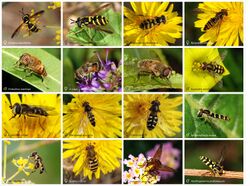
| |
| Sixteen different species of hoverflies | |
| Scientific classification | |
| Domain: | Eukaryota |
| Kingdom: | Animalia |
| Phylum: | Arthropoda |
| Class: | Insecta |
| Order: | Diptera |
| Section: | Aschiza |
| Superfamily: | Syrphoidea |
| Family: | Syrphidae Latreille, 1802 |
| Subfamilies | |
Hoverflies, also called flower flies or syrphids, make up the insect family Syrphidae. As their common name suggests, they are often seen hovering or nectaring at flowers; the adults of many species feed mainly on nectar and pollen, while the larvae (maggots) eat a wide range of foods. In some species, the larvae are saprotrophs, specifically detritivores,[1] eating decaying plant and animal matter in the soil or in ponds and streams. In other species, the larvae are insectivores, preying on aphids, thrips, and other plant-sucking insects.
Insects such as aphids are considered crop pests, so the aphid-eating larvae of some hoverflies are economically and ecologically important. The larvae are potential agents for use in biological control, while the adults are pollinators.
About 6,000 species in 200 genera have been described. Hoverflies are common throughout the world and can be found on all continents except Antarctica. Hoverflies are harmless to most mammals, though many species are mimics of stinging wasps and bees, a mimicry which may serve to ward off predators.
Hoverfly hovering behavior is unlike that of hummingbirds since they do not feed in midair. Hovering in general may be a means of finding a food source. Male hovering is often a territorial display while seeking females,[2] while female hovering serves to inspect ovipositing sites.[3][4][5]
- Adult hoverflies often hover over the plants they visit
File:Syrphidae - kanagawa japan - 2023 11 9.ogv
Description
The size of hoverflies varies depending on the species.[6] For example Paragus tibialis[7][8][9] is 3–5 mm (1⁄8–13⁄64 in) long, while Criorhina nigriventris is 13.6–20.6 mm (17⁄32–13⁄16 in) long.[10] Some, such as members of the genus Baccha, are small, elongated, and slender, while others, such as members of Criorhina, are large, hairy, and yellow and black. As members of the Diptera, all hoverflies have a single functional pair of wings, with the hind wings reduced to balancing organs.[11] Many species are brightly colored, with spots, stripes, and bands of yellow or brown covering their bodies.[11] Due to this coloration, they are often mistaken both by insect-eating birds and by humans for wasps or bees; they exhibit Batesian mimicry. Despite this, hoverflies are harmless to humans.[6] Drone flies, Eristalis tenax, are an example of a species of hoverfly who exhibit Batesian mimicry.[12]
With a few exceptions,[13] Hoverflies are distinguished from other flies by having a spurious vein, located parallel to their fourth longitudinal wing vein.[6] Adults feed mainly on nectar and pollen.[11] Many species also hover around flowers, lending to their common name.[6]
- The legs and mouthparts of hoverflies are usually not particularly long and thin (some bombyliids have a long and needle-like proboscis, many have legs that are noticeably longer and thinner than in similar-sized syrphids)
- Their facial cuticle often has prominent bulges and/or beak- to knob-like projections (most bee flies have an evenly curved or sloping face).
- The wings are often clear or have smooth gradients of tinting, and their veins merge posteriorly into a "false edge" that runs parallel to the wing's true rear edge and extends along half or more of the wing length (bombyliid wings lack a "false rear edge" and often have large dark areas with sharp boundaries, or complex patterns of spots).
- Their abdomens and thoraces often have glossy cuticular body surfaces, abdominal colors are usually mainly due to cuticular pigments (bee flies are usually very hairy, their abdominal colors are almost always due to pigmentation of hairs and not the underlying cuticle).
Reproduction and life cycle

Unlike adults, the maggots of hoverflies feed on a variety of foods. Some are saprotrophs, eating decaying plant or animal matter, while others are insectivores, eating aphids, thrips, and other plant-sucking insects.[6][14] Predatory species are beneficial to farmers and gardeners, because aphids destroy crops, and hoverfly maggots are often used in biological control. That includes one of the most common widespread hoverfly species, Episyrphus balteatus, the larvae of which feed on aphids.[citation needed]
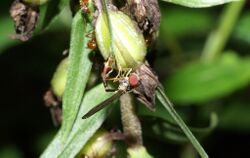
An example of a well-known hoverfly maggot is the rat-tailed maggot of the drone fly, Eristalis tenax. It has a breathing siphon at its rear end, giving it its name.[6] The species lives in stagnant water, such as sewage and lagoons.[15] The maggots also have a commercial use, and are sometimes sold for ice fishing.[16]
Very rarely, hoverfly larvae have caused accidental myiasis in humans. That occurs when the larvae are accidentally ingested from contaminated food.[15][17]
Evolution
The oldest known fossils of crown group Syrphidae are from the Eocene aged Florissant Formation, Green River Formation and Baltic amber. The genus Prosyrphus, found in Late Cretaceous (Cenomanian) Burmese amber, appears to represent a stem group to the family.[18]
Distribution and habitat
Hoverflies are a cosmopolitan family found in most biomes, except extreme deserts, tundra at extremely high latitudes, and Antarctica.[19][20] Certain species are more common in certain areas than others; for example, the American hoverfly, Eupeodes americanus, is common in the Nearctic realm, and the common hoverfly, Melangyna viridiceps, is common in the Australasian realm. About 6,000 species and 200 genera are in the family.[21]
While some hoverfly larvae are aquatic and are often found in stagnant water, those of species that prey upon aphids and other plant parasites are usually terrestrial, residing on leaves.[22] Adults are often found near flowers, their principal food source being nectar and pollen.[11] Some species are inquilines; for instance, members of the genus Volucella can be found in bumblebee nests, while members of Microdon are myrmecophiles, found in ant or termite nests.[6] Others can be found in decomposing vegetation.[citation needed]
Pollination
Hoverflies are important pollinators of flowering plants in many ecosystems worldwide.[23] Syrphid flies are frequent flower visitors to a wide range of wild plants, as well as agricultural crops, and are often considered the second-most important group of pollinators after wild bees. Relatively little research into fly pollinators has been conducted, compared to bees.[23] Bees are thought to be able to carry a greater volume of pollen on their bodies, but flies may be able to compensate for this by making a greater number of flower visits.[citation needed]
Like many pollinator groups, syrphid flies range from species that take a generalist approach to foraging by visiting a wide range of plant species through those that specialize in a narrow range of plants.[24] Although hoverflies are often considered mainly nonselective pollinators, some hoverflies species are highly selective and carry pollen from one plant species.[25] Cheilosia albitarsis is thought to only visit Ranunculus repens.[citation needed]
Specific flower preferences differ among species, but syrphid fly species have repeatedly been shown to prefer white- and yellow-coloured flowers.[26] Nonvisual flower cues such as olfactory cues also help these flies to find flowers, especially those that are not yellow.[27] Many syrphid fly species have short, unspecialized mouth parts and tend to feed on flowers that are more open as the nectar and pollen can be easily accessed.[28]
Also, a number of interactions occur between orchids and hoverflies. The orchid species Epipactis veratrifolia mimics alarm pheromones of aphids which attracts pollinating hoverflies.[29] Another plant, the slipper orchid in southwest China, also achieves pollination by deceit by exploiting the innate yellow color preference of syrphids.[30]
Systematics
Relationship with humans
Adult syrphid flies are pollinators.[citation needed]
Larvae of many hoverfly species prey upon pest insects, including aphids and leafhoppers, which spread some diseases such as curly top, so they are seen in biocontrol as a natural means of reducing levels of pests. Gardeners, therefore, sometimes use companion plants to attract hoverflies. Those reputed to do so include Alyssum spp., Iberis umbellata, statice, buckwheat, chamomile, parsley, and yarrow.[31] Many syrphids, such as Toxomerus marginatus, are attracted to herbivore-induced plant volatiles, and there are commercial formulations of said volatiles, like methyl salicylate, which can be used to attract them for biocontrol purposes.[32] Larvae in the subfamily Eristalinae live in semi-aquatic and aquatic environments, including manure and compost, and can filter and purify water.[citation needed]
Fredrik Sjöberg's book The Fly Trap concerns his enthusiasm for hoverflies on the island of Runmarö in the Baltic Sea.[33] The island is a hotspot for hoverflies and other insects; Sjöberg has collected 58 species of butterflies there, and (in seven years of hunting) 202 species of hoverflies, including 180 in his garden.[34]
Identification guides
- Skevington, J.H., et al., 2019. Field Guide to the Flower Flies of Northeastern North America. Princeton University Press ISBN:9780691189406. This book "covers all 413 known syrphid species that occur in or north of Virginia, Kentucky, and Missouri, west to include Iowa, Minnesota, Ontario, and Nunavut, and east to the Atlantic Ocean, including Greenland."
- Stubbs, A.E. and Falk, S.J. (2002) British Hoverflies An Illustrated Identification Guide. Pub. 1983 with 469 pages, 12 col plates, b/w illus. British Entomological and Natural History Society ISBN:1-899935-05-3. 276 species are described with extensive keys to aid identification. It displays 190 species on colour plates. 2nd edition, pub. 2002, includes new British species and name changes. It includes European species likely to appear in Britain. Additional black and white plates illustrate the male genitalia of the difficult genera Cheilosia and Sphaerophoria.
- van Veen, M.P. (2004) Hoverflies of Northwest Europe: Identification Keys to the Syrphidae. KNNV Publishing, Utrecht ISBN:9050111998.
- Miranda G.F.G., Young A.D., Locke M.M., Marshall S.A., Skevington J.H., Thompson F.C. (2013) Key to the Genera of Nearctic Syrphidae. doi:10.3752/cjai.2013.23
- Bot, S. and Van de Meutter, F. (2023) Hoverflies of Britain and North-west Europe: A photographic guide (Bloomsbury Naturalist). ISBN:978-1-3994-0245-3.
Regional lists
- List of hoverfly species of Great Britain
- List of the Syrphidae of Ireland
- List of flower flies of New Zealand
- List of the flower flies of North America
- Syrphidae of New York State
References
- ↑ Rotheray, G.E. (1993). "Colour Guide to Hoverfly Larvae (Diptera, Syrphidae) in Britain and Europe". Dipterists Digest 9: 155. https://diptera.info/downloads/df_1_9_Colour_Guide_to%20Hoverfly_Larvae.pdf.
- ↑ Collett, T.S.; Land, M.F. (September 1978). "How hoverflies compute interception courses". Journal of Comparative Physiology (Springer-Verlag) 125 (3): 191–204. doi:10.1007/BF00656597. https://www.scopus.com/record/display.uri?eid=2-s2.0-0001324077&origin=inward&txGid=ad71bb12cbc836c7415c848ba45e1ee5.
- ↑ Almohamad, Raki; Verheggen, François J.; HaubrugeUniv, Éric (2009). "Searching and oviposition behavior of aphidophagous hoverflies (Diptera: Syrphidae): a review". Biotechnologie, Agronomie, Société et Environnement 13 (3): 467–481. https://www.researchgate.net/publication/26849775.
- ↑ Vera Strader. "Hover Flies, a Gardener's Friend". University of California Agriculture and Natural Resources. https://ucanr.edu/sites/tuolumne_county_master_gardeners/files/147388.pdf.
- ↑ Peter Chen (December 6, 2023). "Allograpta exotica ovipositing - Allograpta exotica - Female". Iowa State University. https://bugguide.net/node/view/2317562.
- ↑ 6.0 6.1 6.2 6.3 6.4 6.5 6.6 "hoverfly". Encyclopædia Britannica Online. 2009. https://www.britannica.com/EBchecked/topic/273341/hover-fly. Retrieved December 5, 2009.
- ↑ Stubbs, Alan E.; Falk, Steven J (1983). British Hoverflies: An Illustrated Identification Guide (2nd ed.). London: British Entomological and Natural History Society. pp. 253, xvpp. ISBN 1-899935-03-7.
- ↑ Ball, S.G.; Morris, R.K.A. (2000). Provisional atlas of British hoverflies (Diptera, Syrphidae). Monks Wood, UK: Biological Record Centre. pp. 167 pages. ISBN 1-870393-54-6.
- ↑ Van Veen, M.P. (2004). Hoverflies of Northwest Europe, Identification Keys to the Syrphidae (Hardback). Utrecht: KNNV Publishing. p. 254. ISBN 90-5011-199-8.
- ↑ Skevington, Jeffrey H. (2019). Field Guide to the Flower Flies of Northeastern North America. ISBN 9780691189406.
- ↑ 11.0 11.1 11.2 11.3 "Hoverfly". Hutchinson Encyclopedia. Helicon Publishing. 2009. http://encyclopedia.farlex.com/Hover+Fly. Retrieved December 6, 2009.
- ↑ Heal, Jonathan (1979). "Colour patterns of syrphidae:". Heredity (Springer Science and Business Media LLC) 42 (2): 223–236. doi:10.1038/hdy.1979.24. ISSN 0018-067X.
- ↑ Reemer, Menno (2008). "Surimyia, a new genus of Microdontinae, with notes on Paragodon Thompson, 1969 (Diptera, Syrphidae)" (PDF). Zoologische Mededelingen 82: 177–188. http://www.repository.naturalis.nl/record/261778.
- ↑ Schmidt, Martin; Thewes, Ulrich; Thies, Carsten; Tscharntke, Teja (2004). "Aphid suppression in mulched cereals". Entomologia Experimentalis et Applicata 113 (2): 87–93. doi:10.1111/j.0013-8703.2004.00205.x.
- ↑ 15.0 15.1 "Intestinal myiasis caused by Eristalis tenax". Journal of Clinical Microbiology 37 (9): 3082. September 1999. doi:10.1128/JCM.37.9.3082-3082.1999. PMID 10475752.
- ↑ Dictionary of Ichthyology; Brian W. Coad and Don E. McAllister at ww.briancoad.com
- ↑ Whish-Wilson PB (2000). "A possible case of intestinal myiasis due to Eristalis tenax". The Medical Journal of Australia 173 (11–12): 652. doi:10.5694/j.1326-5377.2000.tb139374.x. PMID 11379520. http://www.mja.com.au/public/issues/173_11_041200/whishwilson/whishwilson.html.
- ↑ Grimaldi, David A. (2018-10-24). "Basal Cyclorrhapha in amber from the Cretaceous and Tertiary (Insecta: Diptera), and their relationships: Brachycera in Cretaceous amber Part IX". Bulletin of the American Museum of Natural History 423 (423): 1–97. doi:10.1206/0003-0090-423.1.1. ISSN 0003-0090. https://zenodo.org/record/4613008.
- ↑ Barkemeyer, Werner. "Syrphidae (hoverflies)". Biodiversity Explorer. South Africa: Iziko Museum. http://www.biodiversityexplorer.org/flies/syrphidae/index.htm.
- ↑ Thompson, F. Christian (August 19, 1999). "Flower Flies". The Diptera Site. United States Department of Agriculture. http://www.sel.barc.usda.gov/diptera/syrphid/syrphid.htm.
- ↑ Philip J. Scholl; E. Paul Catts; Gary R. Mullen (2009). "Myiasis (Muscoidea, Oestroidea)". Medical and Veterinary Entomology (2nd ed.). Academic Press. pp. 309–338. ISBN 978-0-12-372500-4. https://books.google.com/books?id=6R1v9o-uaI4C&pg=PA309.
- ↑ Laura Smith. "Syrphidae, hoverflies". bumblebee.org. http://www.bumblebee.org/invertebrates/DipteraHoverflies.htm.
- ↑ 23.0 23.1 Larson, B.M.H.; Kevan, P.G.; Inouye, D. W. (2001). "Flies and flowers: taxonomic diversity of anthophiles and pollinators.". Canadian Entomologist 133 (4): 439–465. doi:10.4039/ent133439-4.
- ↑ Van Der Kooi, C. J.; Pen, I.; Staal, M.; Stavenga, D. G.; Elzenga, J. T. M. (2015). "Competition for pollinators and intra-communal spectral dissimilarity of flowers". Plant Biology 18 (1): 56–62. doi:10.1111/plb.12328. PMID 25754608. https://www.researchgate.net/publication/273158762.
- ↑ Haslett, J.R. (1989). "Interpreting patterns of resource utilization: randomness and selectivity in pollen feeding by adult hoverflies". Oecologia 78 (4): 433–442. doi:10.1007/bf00378732. PMID 28312171. Bibcode: 1989Oecol..78..433H.
- ↑ Sajjad, Asif; Saeed, Shafqat (2010). "Floral host plant range of syrphid flies (Syrphidae: Diptera) under natural conditions in southern punjab, Pakistan.". Pakistan Journal of Biology 42 (2): 1187–1200.
- ↑ Primante, Clara; Dotterl, Stefan (2010). "A syrphid fly uses olfactory cues to find a non-yellow flower.". Journal of Chemical Ecology 36 (11): 1207–1210. doi:10.1007/s10886-010-9871-6. PMID 20924654.
- ↑ Campbell, Alistair, J.; Biesmeijer, J. C.; Varma, V.; Wakers, F. L. (2012). "Realising multiple ecosystem services based on the response of three beneficial insect groups to floral traits and trait diversity". Basic and Applied Ecology 13 (4): 363–370. doi:10.1016/j.baae.2012.04.003.
- ↑ Stokl, Johannes; Brodmann; Dafni; Ayasse; Hansson (2011). "Smells like aphids: orchid flowers mimic aphid alarm pheromones to attract hoverflies for pollination.". Proc. R. Soc. B 278 (1709): 1216–1222. doi:10.1098/rspb.2010.1770. PMID 20943694.
- ↑ Shi, J.; Luo, Y.B.; Ran, J.C.; Liu, Z.J.; Zhou, Q. (2009). "Pollination by deceit in Paphiopedilum barbigerum (Orchidaceae): a staminode exploits innate colour preferences of hoverflies (Syrphidae).". Plant Biology 11 (1): 17–28. doi:10.1111/j.1438-8677.2008.00120.x. PMID 19121110.
- ↑ Ben-Issa, R., Gomez, L., & Gautier, H. (2017). Companion Plants for Aphid Pest Management. Insects, 8(4), 112. https://doi.org/10.3390/insects8040112
- ↑ Rodriguez-Saona, C., Kaplan, I., Braasch, J., Chinnasamy, D., & Williams, L. (2011). Field responses of predaceous arthropods to methyl salicylate: A meta-analysis and case study in cranberries. Biological Control, 59(2), 394-303. https://doi.org/10.1016/j.biocontrol.2011.06.017
- ↑ Sjöberg, Fredrik (2014). The Fly Trap. Particular Books. p. 197. ISBN 978-1-84614-776-0.
- ↑ Barkham, Patrick (14 June 2014). "Fredrik Sjöberg: 'I realised I had to write my book for people not interested in flies'". The Guardian. https://www.theguardian.com/books/2014/jun/14/fredrik-sjoberg-hoverflies-the-fly-trap.
External links
- Hoverfly – index to scholarly articles
- All About Hoverflies
- A website about Dutch hoverflies
- Hoverfly Recording Scheme – UK Dipterists Forum
- Syrphidae species in Europe and Africa, with photos, range maps, checklists and literature
- Diptera.info Picture Gallery
Species lists
- Nearctic at nearctica.com
- West Palaearctic including Russia at faunaeur.org
- Australasian/Oceanian at bishopmuseum.org
- List of the flower flies of North America
- List of hoverfly species of Great Britain
- Syrphidae of New York State
- List of flower flies of New Zealand
Wikidata ☰ Q217905 entry
 |
